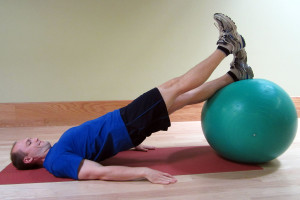Spring soccer season has begun! ACL injury can be devastating. Unfortunately, it’s a common injury that occurs in soccer as well as other sports. The ACL (Anterior Cruciate Ligament) is an important ligament of the knee that is responsible for knee stability. ACL injury often occurs in combination with other injury to the knee, including injury to the medial collateral ligament (MCL) and the meniscus. Depending on the severity, surgery is typically indicated to correct an injury to the ACL and meniscus. Discover the risk factors for ACL injury, and learn how to implement strategies in order to avoid injury while staying active in sports.
Risk Factors for ACL Injury:
- More common in females.
- Hamstring weakness.
- Poor lower leg strength.
- Poor core strength and stability.
- Knee laxity.
- Genetic anatomical variations including: certain bone shapes in the tibia, femur, and the knee joint, as well as a wider q-angle in women (due to the shape of the pelvis, the angle of the femur to the tibia is larger).
- Prior ACL injury.
- Extrinsic factors such as weather conditions and different surfaces (typically those surfaces that have a high level of friction and little give such as turf or playing indoors).
- Higher body mass.
When surgery is needed to repair the ligament, an ACL injury is a season ending process with a long recovery. It can take 9-18 months to adequately heal and recover from injury prior to returning to pre-injury levels. Therefore, it’s critical to take steps to limit your risk of injury.
6 Tips for Avoiding ACL Injury:
1. Increase your core strength and stability. Please refer to Core Exercises for ACL Injury Prevention for detailed descriptions and photos of my recommended core stability exercises.
2. Increase your lower leg strength and focus on your hamstrings. Hamstring strength is critical in avoiding ACL injury. In general, lower leg strength is a critical component in avoiding injury. Perform exercises such as the squat (for general lower leg strength) as well as lunges and the straight leg dead lift to increase hamstring strength. For more ideas on how to improve your leg and hip strength, please refer to Q & A: How to Increase Hip Strength and Improve Mobility.
3. Add plyometric exercise to your routine. Plyometrics is an excellent technique to improve strength and explosive power to your lower legs. When performing the movements, be sure to focus on the alignment of your legs and knees. Let the knees absorb the force, then rebound out of the movement. Don’t allow your legs to buckle inward. Keep the patella (knee cap) in line with your second toe to insure proper form.
4. Focus on sport specific mobility drills. Sports, such as soccer, football, and basketball, have higher rates of ACL injury. Be sure to work on sport specific mobility drills. Focus particularly on proper landing after jumping, decelerating movements, and quick cutting movements. When performing these drills, don’t allow your legs to buckle inward. Keep the patella (knee cap) in line with your second toe to insure proper form.
5. Improve your balance. Balance is an important part of mobility. It is usually overlooked and taken for granted until mobility is significantly affected. In How to Improve Balance Using a Water Noodle, I demonstrate a clock drill which I highly recommend you perform in order to maintain and improve your balance. Also, please refer to Q & A: How Do I Improve Balance (Part II) for specific suggestions on how to improve balance in each of the five body systems.
6. Participate in an ACL conditioning program. The Santa Monica ACL Prevention Project developed an ACL Injury Prevention Program specifically for female soccer players. This 15-minute training program incorporates balance, agility, and performance drills into the warm up phase of training and practice. This particular ACL prevention training plan has 6 phases including: warm up; stretching; strengthening; plyometrics and/or agility drills; and cool down. The conditioning program is usually performed two to three times per week.
Incorporate these 6 tips and strategies as part of your normal training and cross training routine to avoid ACL injury. They can be incorporated into your off season as well as part of an in season training program. If you suspect an ACL injury, please consult with your physician, physical therapist (PT), or athletic trainer (ATC).
Do you participate in an ACL prevention program? Which specific tip can you incorporate into your routine? Please leave your comments below.
If you have a question that you would like featured in an upcoming blog post, please comment below or submit your question to contact@thePhysicalTherapyAdvisor.com. Be sure to join our growing community on Facebook by liking The Physical Therapy Advisor!


I find to squat more efficient and improve overall hip strength doing hip extensions/bridges with or without weight really helps my weakness in the hips
I agree! I like to bridge and perform hip extensions as well to help prepare the glutes after prolonged sitting. It works well before weight lifting or running.